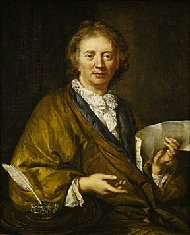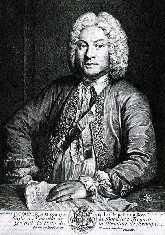|
|
François Couperin (Composer) |
|
Born: November 10, 1668 - Paris, France
Died: September 11, 1733 - Paris, France |
|
François Couperin was a French Baroque composer, organist and harpsichordist. François Couperin was known as "Couperin le Grand" (Couperin the Great) to distinguish him from the other members of the musically talented Couperin family. |
|
Life |
|
François Couperin was taught by his father, Charles Couperin, who died when François was 10, and by Jacques Thomelin. In 1685 he became the organist at the church of Saint-Gervais, Paris, a post he inherited from his father and that he would pass on to his cousin, Nicolas Couperin. Other members of the family would hold the same position in later years. In 1693 Couperin succeeded his teacher Thomelin as organist at the Chapelle Royale (Royal Chapel) with the title organiste du Roi, organist by appointment to the King. This was the Sun King, Louis XIV.
In 1717 François Couperin became court organist and composer, with the title ordinaire de la musique de la chambre du Roi. With his colleagues, Couperin gave a weekly concert, typically on Sunday. Many of these concerts were in the form of suites for violin, viol, oboe, bassoon and harpsichord, on which he was a virtuoso player. |
|
Works |
|
François Couperin acknowledged his debt to the Italian composer Arcangelo Corelli. He introduced A. Corelli's trio sonata form to France. Couperin's grand trio sonata was subtitled Le Parnasse, ou l'Apothéose de Corelli (Parnassus, or the Apotheosis of Corelli). In it he blended the Italian and French styles of music in a set of pieces which he called Les Goûts réunis ("Styles Reunited").
His most famous book, L'Art de toucher le clavecin (The Art of Harpsichord Playing, published in 1716), contained suggestions for fingerings, touch, ornamentation and other features of keyboard technique. They influenced J.S. Bach. J.S. Bach adopted the fingering system, including the use of the thumb, that Couperin set forth for playing the harpsichord.
F. Couperin's four volumes of harpsichord music, published in Paris in 1713, 1717, 1722, and 1730, contain over 230 individual pieces, which can be played on solo harpsichord or performed as small chamber works. These pieces were not grouped into suites, as was the common practice, but ordres, which were Couperin's own version of suites containing traditional dances as well as descriptive pieces. The first and last pieces in an ordre were of the same tonality, but the middle pieces could be of other closely-related tonalities. These volumes were loved by J.S. Bach and, much later, Richard Strauss, as well as Maurice Ravel who memorialized their composer with Le Tombeau de Couperin (A Memorial to Couperin).
Many of F. Couperin's keyboard pieces have evocative, picturesque titles and express a mood through key choices, adventurous harmonies and (resolved) discords. They have been likened to miniature tone poems. These features attracted Richard Strauss, who orchestrated some of them.
Johannes Brahms's piano music was influenced by the keyboard music of F. Couperin. J. Brahms performed Couperin's music in public and contributed to the first complete edition of Couperin's Pièces de clavecin by Friedrich Chrysander in the 1880's.
As the early-music expert Jordi Savall has pointed out, Couperin was the "poet musician par excellence." He believed in "the ability of Music (with a capital M) to express itself in sa prose et ses vers " (prose and poetry). He believed that if we enter into the poetry of music, we discover that it is "plus belle encore que la beauté" (more beautiful than beauty itself). |
|
See also: List of compositions by François Couperin (Wikipedia) |
|
Organ |
|
Only one collection of organ music by François Couperin survives, the Pièces d'orgue consistantes en deux Messes (Pieces for organ consisting of two Masses), the first manuscript of which appeared around 1689-1690. At only age 21, Couperin likely had neither the funds nor the reputation to justify widespread publication, but the work was approved by his teacher, Michel Richard Delalande, who wrote that the music was "very beautiful and worthy of being given to the public." The two Masses were intended for different audiences: the first for parishes or secular churches ("paroisses pour les fêtes solemnelles"), and the second for convents or abbey churches ("couvents de religieux et religiouses"). These masses are divided into many movements in accordance with the traditional structure of the Latin Mass: Kyrie (5 mvts.), Gloria (9), Sanctus (3), Agnus (2), and two additional movements (an Offertoire and a Deo gratias to conclude each mass).
In composing the masses, F. Couperin follows techniques used in masses by Nivers, Lebègue, and Boyvin, as well as other predecessors of the French Baroque era. In the paroisses Mass, he uses plainchant from the Missa cunctipotens genitor Deus as a cantus firmus in two Kyrie movements and the first Sanctus movement; the Kyrie Fugue also uses a chant incipit to derive its subject. The Mass for couvents contains no plainchant, as each convent and monastery maintained its own, nonstandard body of chant. Couperin departs from his predecessors in many ways, however; the melodies of the Récits are strictly rhythmic and more directional than previous examples of the genre. Willi Apel writes that "this music shows a sense of natural order, a vitality, and an immediacy of feeling that breaks into French organ music like a fresh wind."
The longest piece in the collection is the Offertoire sur les grands jeux of the first Mass. The form is akin to that of an expanded French overture, in three large sections: a prelude, a chromatic fugue in minor, and a gigue-like fugue. Bruce Gustafson has called the movement a "stunning masterpiece of the French classic repertory." The second Mass also contains an Offertoire with a similar form, but this movement is considered by some, along with the rest of the Mass, to be rather inferior to the first. Apel writes, "In general, [Couperin] did not expend the same care for this Mass, which was written for modest abbey churches, as for the other one, which he himself certainly presented on important holidays on the organ of Saint-Gervais." |
|
J.S. Bach Connection |
|
J.S. Bach's high opinion of François Couperin is attested by Friedrich Wilhelm Marpurg, who wrote in 1750: 'I can do no more in praise of Couperin than to inform you that the learned J.S. Bach regarded him as worthy of approbation' (BDok iii, no. 632). J.S. Bach seems to have owned a copy of Couperin's Second livre de pieces de clavecin (Paris, 1716-1717), for the rondeau Les Bergeries was copied from it by J.S. Bach's wife Anna Magdalena Bach in her Clavierbüchlein of 1725, and the Allemande in A major 'à deux clavecins' from the same book was written out by J.S. Bach's eldest son Wilhelm Friedemann Bach when he was still a child.
The organ arrangement, attributed to J.S. Bach (BWV 587), of L'!mperiale from Les Nations (Paris, 1726) is of doubtful authenticity. |
|


|
|
Source: Wikipedia Website; Malcom Boyd, editor: Oxford Composer Companion J.S. Bach (Oxford University Press, 1999, Article author: Richard D.P. Jones)
Contributed by Aryeh Oron (November 2008) |
|
François Couperin : Short Biography | François Couperin & Bach |
|
Works previously attributed to J.S. Bach |
|
Rondeau for keyboard in B flat major (original title: Les Bergeries), BWV Anh 183 [AMN II/6] |
|
Works arranged by J.S. Bach |
|
Aria for organ in F major, BWV 587 [Trio No. 4 from the Suite L'Imperial for 2 violins & bc (included in "Les Nations. Sonades et suites de simphonies et trios (...)"] [Doubtful] |
|
Links to other Sites |
|
François Couperin (Wikipedia)
François Couperin (Le Grand): a biographical note (Baroque Music)
François Couperin Biography (Naxos)
François Couperin (Karadar)
François Couperin: Biography (Sojurn)
François Couperin (IMDB)
François Couperin biography (Kunst der Fuge)
HOASM: François Couperin
François Couperin (Classic Cat)
François Couperin (Britannica)
François Couperin Le Grand, Biography, Discography (Goldberg) |
|
Bibliography |
|
Willi Apel : The History of Keyboard Music to 1700 (Bloomington: Indiana University Press, 1972), p. 736-738.
Bruce Gustafson: "France" in Keyboard Music Before 1700, ed. Alexander Silbiger (New York: Routledge, 2004), p. 115-116.
Edward Higginbottom. "Couperin: (4) François Couperin (ii) [le grand]", Grove Music Online, ed. L. Macy (accessed November 30, 2007)
John Gillespie: Five Centuries of Keyboard Music: An historical survey of music for harpsichord and piano (New York NY: Dover Publications, Inc., 1965)
Philippe Beaussant: François Couperin, translated from the French by Alexandra Land (Portland OR: Amadeus Press, 1990)
Wilfrid Mellers: "Francois Couperin and the French Classical Tradition", London UK:Faber & Faber; 2nd edition (October 1987) |
|
|